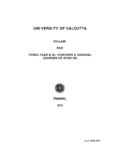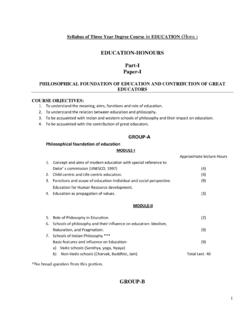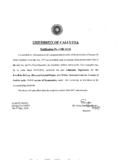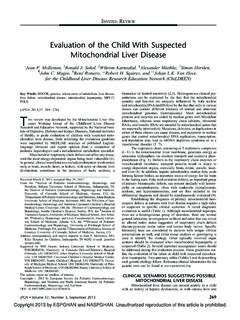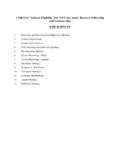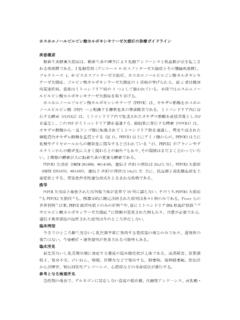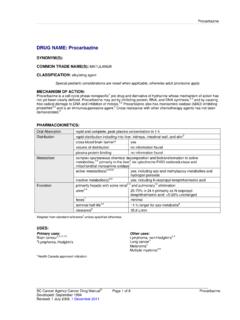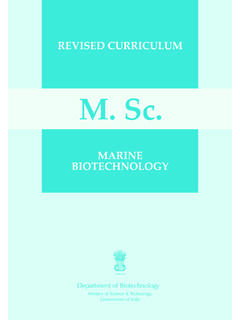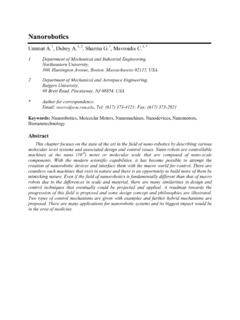Transcription of Physiology Syllabus Final - University of Calcutta
1 University OF Calcutta . SYLLABI. F. O. R. THREE-YEAR HONOURS AND GENERAL. DEGREE COURSES OF STUDIES. Physiology . 2010. 1. 2010-11. HONOURS. PART I. Theoretical Paper I ( 100). Unit -01 : 50 Marks Lectures required (Each period of 45 minutes duration). 1. Cell Biology I 08. 2. Cell Biology II 12. 3. Biophysics 16. 4. Enzyme 10. 5. Digestive System 14. Unit- 02 : 50 Marks 1. Biochemistry-I 10. 2. Biochemistry-II 12. 3. Vitamins and Minerals 14. 4. Muscle Physiology 12. 5. Nerve Physiology 12. Paper II A: ( 50). Unit 03 : 50 Marks Lectures required (Each period of 45 minutes duration). 1. Blood 14. 2. Cardiovascular System I 14. 3. Cardiovascular System II 10. 4. Body Fluids and Regional Circulation 08. 5. Respiratory System 14. Paper II B Practical ( 50). (One practical class is of 3 periods) Classes required 50. (Each period of 45 minutes duration). Unit 04 : 50 Marks 1. Histology Haematological Experiments 15 marks Permanent slide identification 15 marks 2.
2 Biochemistry Qualitative Experiments 10 marks 3. Viva Voce 5 marks 4. Laboratory Note Books 5 marks 2. PART II. Theoretical Paper III ( 100). Unit -05 : 50 Marks Lectures required (Each period of 45 minutes duration). 1. Nervous System I 10. 2. Nervous System II 14. 3. Nervous System III 14. 4. Nervous System IV 14. 5. Molecular neurobiology 08. Unit 06 : 50 Marks 1. Instrumentation 12. 2. Renal Physiology 14. 3. Sensory Receptors, Olfaction & Gustation 10. 4 Audition 10. 5. Vision 14. Paper IV A ( 50). Unit 07 50 Marks Lectures required (Each period of 45 minutes duration). 1. Biological Oxidation and Carbohydrate Metabolism 12. 2. Amino acids and Purine & Pyrimidine Metabolism 10. 3. Lipid Metabolism and Reactive Oxygen Species 12. 4. Methodologies 10. 5. Molecular Biology 16. Practical Paper IVB ( 50). (One Practical class is of 3 periods) Classes required 50. (Each period of 45 minutes duration). Unit 08 : 50 Marks 1.
3 Histology Fresh Tissue Experiments 10 marks 2. Biochemistry Quantitative Estimations 15 marks 3. Experimental Physiology 15 marks Amphibian skeletal muscle experiments Amphibian unperfused heart experiments 4. Viva Voce 5 marks 5. Laboratory Note Books 5 marks 3. PART III. Theoretical Paper V ( 100). Unit 09 : 50 Marks Lectures required (Each period of 45 minutes duration). 1. General Endocrinolgy I 14. 2. General Endocrinolgy II 12. 3. General Endocrinolgy III 12. 4. General Endocrinolgy IV 14. 5. Chronobiology 08. Unit 10 : 50 Marks Lectures required (Each period of 45 minutes duration). 1. Reproductive Physiology I 14. 2. Reproductive Physiology II 14. 3. Developmental Biology 12. 4. Nutrition and Dietetics 12. 5. Social Physiology 08. Paper VI ( 100). Unit- 11 : 50 Marks Lectures required (Each period of 45 minutes duration). 1. Work Physiology and Ergonomics 15. 2. Sports Physiology 15. 3. Skin and Body Temperature Regulation 10.
4 4. Human and Environment I 10. 5. Human and Environment II 10. Unit - 12 : 50 Marks 1. Microbiology I 12. 2. Microbiology II 10. 3. Immunology 14. 4. Pharmacology 12. 5. Biostatistics 12. 4. Practical Paper VII ( ). (One Practical class is of 3 periods) Classes Required 70. (Each period of 45 minutes duration). Unit - 13. 1. Biochemistry 40 Marks 2. Experimental Physiology 25 Marks 3. Microbiology & Biochemical Technique 10 Marks 4. Viva Voce 15 Marks 5. Laboratory Note Books 10 marks Paper VIII ( 100). (One Practical class is of 3 periods) Classes Required 70. (Each period of 45 minutes duration). Unit - 14. 1. Histology 15 Marks 2. Experimental Physiology 20 Marks 3. Experiments on Work Physiology and Ergonomics using human subjects 15 Marks 4. Biostatistics 10 Marks 5. Social Physiology Diet Survey 08 Marks Field Study Record 07 Marks 6. Viva Voce 15 Marks 7. Laboratory Note Books 10 Marks 5. PART-I. Theoretical PAPER I ( 100).
5 UNIT : 01 (50 Marks). 1. Cell Biology I : Electron microscopic structure and functions of eukaryotic endoplasmic reticuli, ribosome, golgi bodies, mitochondria, lysosomes, peroxisomes cytoskeletal elements, centrosomes and plasma membrane and subcellular membrane. Ion pores, ion pumps, ion channels, ionophores, passive transport . facilitated diffusion, uniport, symport, antiport. Active membrane liposome and erythrocyte ghost. Basic idea of tight junctions, gap junctions and cell adhesion molecules. (08 lectures). 2. Cell Biology II : (a) Genetics : Chromosome structure morphology. Chromosomal DNA packaging nucleosomes and higher levels of organization of chromatin. Euchromatin and heterochromatin. Human genome and its characteristics. Nuclear and mitochondrial DNA. Cell cycle events and regulatory role of cyclin. Elementary idea of apoptosis. (b) Cell Signalling : Cell surface receptor proteins ion channel coupled, G-protein coupled and enzyme-coupled.
6 Intracellular messengers cAMP, cGMP, IP3, DAG, Protein kinases, Ca 2+, CO, NO. Signal transduction pathways Phosphatidylinositides, MAP kinase, JAK-STAT, SMAD. (12 lectures). 3. Biophysics : Diffusion, surface tension and viscosity -- their characteristics, factors influencing and biological applications. Osmosis: osmotic pressure laws, determination freezing point depression method and biological applications. Protolysis of water, pH, acid-base neutralization curves, Buffer action: Henderson-Hasselbalch equation. Regulation of pH by blood buffers. Determination of pH . Basic concept of indicators, principle of pH meter- hydrogen electrode and glass electrode. Colloids : Classification, properties optical, electrical, electrokinetic. Biological importance of colloids. Dialysis and ultrafiltration. Gibbs-Donnan membrane equilibrium. Thermodynamics : Type of surroundings and systems. First Law Internal energy, enthalpy.
7 Second Law Entropy, Free energy change, Endergonic and Exergonic reactions, Reversible and Irreversible processes, Equilibrium constant. Physiological steady-state, Living body as a thermodynamic system. (16 lectures). 4. Enzymes : Classification- EC nomenclature, Concept of apoenzyme, holoenzyme, coenzyme, cofactors and prosthetic group. Mechanism of enzyme action : Activation energy, Enzyme-substrate complex, Transition state and Products. Models of enzyme-substrate interactions. Specificity of enzymes. Concept of initial rate, maximum velocity and steady-state kinetics. Michaelis constant, Michaelis-Menten equation, Graphical representation of hyperbolic kinetics-- Lineweaver-Burk plot. Significance of Km and Vmax. Factors influencing enzyme-catalyzed reactions : substrate concentration, enzyme concentration, pH, temperature. Competitive, non-competitive and uncompetitive inhibitions. Regulation of enzyme activities -- covalent modifications, allosteric modifications Sigmoid kinetics and Hill equation : K- and M- series, Feed-back inhibition.
8 Rate-limiting enzymes. Isozymes, Ribozymes and Abzymes. (10 Lectures). 6. 5. Digestive System : Anatomy and histology of alimentary canal. Digestive glands histological structures of salivary glands, pancreas, liver. Deglutition. Movements of alimentary canal and their regulations. Composition, functions and regulation of the secretion of salivary, gastric, pancreatic and intestinal juices and bile. Synthesis of Bile acids. Enterohepatic circulation. Digestion and absorption of carbohydrates, lipids, proteins and nucleic acids. Defecation. Feces. GALT. Basic concepts of Peptic Ulcer, Jaundice and Gall-stones. (14 Lectures). UNIT :02 (50 MARKS). 1. Biochemistry I : Carbohydrates : Definition and classification. Monosaccharides Classification, structure, stereoisomerism, optical isomerism, optical activity, epimerism. Cyclic structures- Pyranose and furanose forms, anomerism, mutarotation and its mechanism. Chemical reactions of monosaccharides (Glucose & Fructose) ---- Reactions with concentrated mineral acids, alkali, phenylhydrazine and their biochemical importance.
9 Derivatives of monosaccharides -----Amino sugars, deoxy sugars, sugar alcohols, sugar acids, sugar esters, their biochemical and physiological importance. Disaccharides Maltose, Lactose and Sucrose : Structure, Occurrence and Physiological importance. Polysaccharides Starch, Glycogen, Dextrin, Cellulose, Glycosaminoglycans, Glycoproteins, Sialic acids, Lectins, Blood group polysaccharides. Lipids : Definition and classification. Fatty acids ----- Classification, systemic nomenclature and , Di- and Triglycerides. Properties of Fat and Fatty acids Hydrolysis, Saponification, Saponification number, Iodine number, Acetylation - Acetyl number. Hydrogenation, Rancidity-Acid number, Reichert-Meissl number. Cis-trans isomerism. Eicosanoids, Phospholipids, Glycolipids, Sphingolipids, Cholesterol & its ester ---- their structure and physiological importance. Lipoproteins - Structure and classification. (10 Lectures). 2.
10 Biochemistry II : Amino acids : Classification, Structure, Nomenclature and Optical properties. Protonic equilibria of amino acids Zwitterions, Isoelectric point, titration curve of amino acids. Reactions with ninhydrin and formaldehyde. Peptides and Proteins : Structure and properties of peptide bonds -- Phi and Psi angles. Reactions with Sanger's and Edman's reagent. Biuret reaction. Different levels of protein structure -- Primary, Secondary ( -helix and -pleated sheet), Tertiary and Quarternary. Forces stabilizing the structures. Denaturation and Renaturation. Purine and Pyrimidine : Structure, nomenclature and tautomerism. Nucleic acids : Nucleosides and Nucleotides ----- structure. Polynucleotides. DNA double helix --- Primary, Secondary and Tertiary structure. A-DNA, B-DNA and Z-DNA. RNA ----- Structure and types. Denaturation and annealing of DNA. Hyperchromicity, melting temperature and half Cot value.
